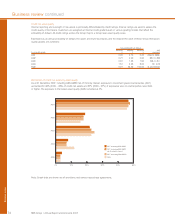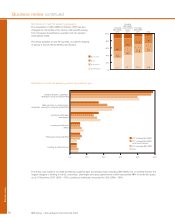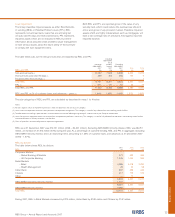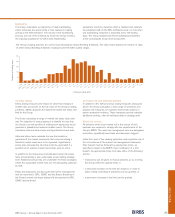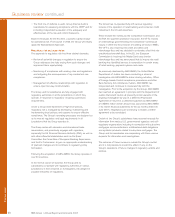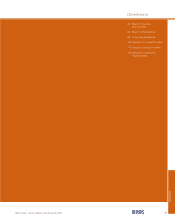RBS 2007 Annual Report Download - page 85
Download and view the complete annual report
Please find page 85 of the 2007 RBS annual report below. You can navigate through the pages in the report by either clicking on the pages listed below, or by using the keyword search tool below to find specific information within the annual report.
Business review
83
RBS Group • Annual Report and Accounts 2007
The Group also provides liquidity back-up facilities to its own
conduits and has small exposures to other selected conduits
which take funding from the asset-backed commercial paper
(“ABCP”) market. The short-term contingent liquidity risk in
providing such backup facilities is mitigated by the spread of
maturity dates of the commercial paper taken by the conduits.
Limits sanctioned for such facilities totalled approximately
£64 billion at 31 December 2007, of which £16 billion related
to the RBS conduits and £48 billion to ABN AMRO conduits.
The RBS conduits are multi-seller ABCP conduits rated at A1
or A1+/P1 levels. During the difficult market conditions since
August 2007 the conduits were generally able to continue to
issue rated CP albeit at generally shorter maturities and higher
price levels than previously. There was an increased shortage
of market liquidity, particularly in November and December, for
longer dated issuance (i.e. over 1 month) as the year end
approached. RBS and RBS Greenwich Capital Markets act as
dealers to the conduits’ CP issuance programmes and have
purchased CP in that capacity but such holdings have not
generally been material. The majority of the ABN AMRO
conduits are also rated A1 or A1+/P1 and they experienced
similar trading conditions to the RBS conduits although they
saw two small conduits draw liquidity. ABN AMRO Bank and
ABN AMRO Corp act as dealers to the programmes and have
held generally non material CP on inventory. The conduits are
consolidated by the Group.
Developments in liquidity risk management regulation
During 2007, increased regulatory focus and the need for
international coordination of liquidity risk management has
been highlighted by external market conditions.
New liquidity regulation was also introduced by a number of
local regulators, notably in the Republic of Ireland. The Group
had no difficulties in meeting the new requirements.
Further regulatory developments are expected through 2008,
including progress in harmonising liquidity requirements.
Central Banks are also expected to continue to work to
coordinate their liquidity supply arrangements in order to
mitigate market conditions. The Group has been, and
continues to be, actively involved in working with the various
regulatory policy makers and central banks to assist the
development of an appropriate future liquidity regime which
takes into account both national considerations and the
integrated cross-border approach to the management of
liquidity risk within integrated banking groups such as the
Group.
Market risk
Market risk is defined as the risk of loss resulting from adverse
changes in risk factors such as interest rates, foreign currency
and equity prices, together with related factors such as market
volatilities.
The Group is exposed to market risk because of positions held
in its trading portfolios as well as its non-trading business
including the Group’s treasury operations.
There are two sources of market risk for the Group:
•Trading: the principal risk factors for the Group are interest
rates, credit spreads, equity prices and foreign exchange.
The primary focus of the Group’s trading activities is client
facilitation – providing products to the Group’s client base at
competitive prices. The Group also undertakes: market
making – quoting firm bid (buy) and offer (sell) prices with
the intention of profiting from the spread between the
quotes; arbitrage – entering into offsetting positions in
different but closely related markets in order to profit from
market imperfections; and proprietary activity – taking
positions in financial instruments as principal in order to take
advantage of anticipated market conditions.
Financial instruments held in the Group’s trading portfolios
include, but are not limited to: debt securities, loans,
deposits, equities, securities sale and repurchase
agreements and derivative financial instruments (futures,
forwards, swaps and options).
For a discussion of the Group’s accounting policies for, and
information with respect to, its exposures to derivative
financial instruments, see Accounting policies and Note 13
on the accounts.
•Non-trading: the principal market risks arising from the
Group’s non-trading activities are interest rate risk, currency
risk and equity risk.
Treasury activity and mismatches between the repricing of
assets and liabilities in its retail and commercial banking
operations account for most of the non-trading interest rate
risk. Non-trading currency risk derives from the Group’s
investments in overseas subsidiaries, associates and
branches.
The Group’s strategic investment in Bank of China, venture
capital portfolio and investments held by its general
insurance business are the principal sources of non-trading
equity price risk.
The Group’s portfolios of non-trading financial instruments
mainly comprise loans (including finance leases), debt
securities, equity shares, deposits, certificates of deposit
and other debt securities issued, loan capital and
derivatives. To reflect their distinct nature, the Group’s long-
term assurance assets and liabilities attributable to
policyholders have been excluded from these market risk
disclosures.
Strategy and process
GEMC approves the Group’s trading book market risk appetite,
expressed in value-at-risk (VaR) and stress testing limits. These
limits are delegated to individual trading businesses within the
Group. The Board, GEMC and GRC review monthly reports,
which provide summary information on VaR, trading positions
and stress tests.



